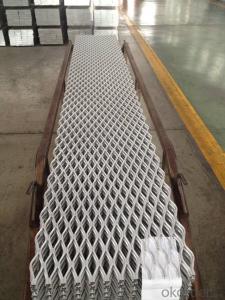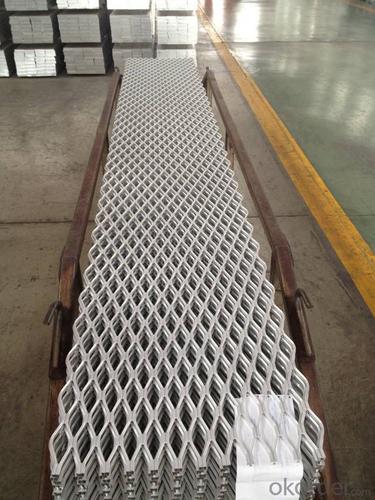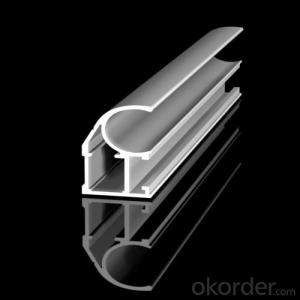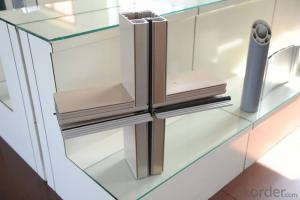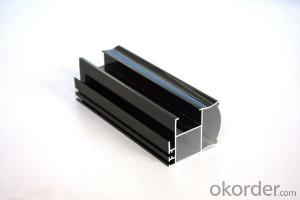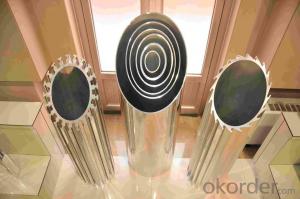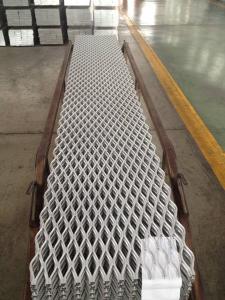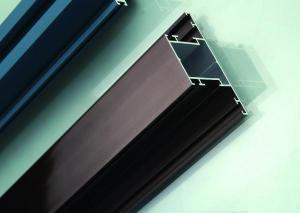Aluminum Alloy Profiles Walkway
OKorder Service Pledge
OKorder Financial Service
You Might Also Like
We are the largest aluminum profilemanufacture in
The detail descriptions of aluminum profile as bellowing:
Alloy Aluminum 6063,6061,6005,6082 or customer nominated | |
Temper | T3, T4, T5, T6 and other |
Surface | Anodize, electrophoresis, powder coating, PVDF coating, etc. |
Colour | Any colour based on Standard Germany RAL Mark |
Length | Not more than 16 meters |
Good Package | Inner plastic film /outside carton/wooden pallets |
Payment Method | T/T, L/C, etc |
Delivery Time | Normally 2-4 weeks, Delivery time can be consulted. |
Press Machine | 500-12500 tons all together 93 press lines. |
Fabrication | 1. Windows and doors; 2. Drilling; 3. Bending; 4. Cutting; 5. etc. |
Certificate | ISO/TS 16949,DNV,IRIS,CCS,AFA,etc. |
Dies | 1. Using our dies, no fee; |
2. Using customer drawing, opening dies, usually about 5~50 tons then the dies cost can be refunded. | |
3. Die cost is negotiable base on the order quantity | |
Capability | Annual output 800,000 tons |
- Q: What are the different fastening options available for aluminum profiles?
- There are several different fastening options available for aluminum profiles, depending on the specific application and desired functionality. Some common fastening options include: 1. Screws: Using screws is a widely used method to fasten aluminum profiles. They can be easily installed and provide a strong and secure connection. Self-tapping screws are often used, as they create their own threads in the aluminum profile. 2. Bolts and nuts: Bolts and nuts offer another reliable fastening option for aluminum profiles. They provide a strong connection and can be easily tightened or loosened as needed. It is important to select the appropriate bolt and nut size and ensure proper tightening to prevent stripping or loosening of the connection. 3. T-slot nuts: T-slot nuts are designed specifically for T-slot aluminum profiles, which have a groove along the length of the profile. T-slot nuts slide into the groove and can be easily positioned and tightened using a hex key. They provide a versatile and adjustable fastening option, allowing for easy repositioning or modification of the profile. 4. Clamps: Clamps are commonly used to secure aluminum profiles together or attach other components to the profile. They come in various designs, such as corner clamps or angle clamps, and provide a quick and easy way to assemble or disassemble aluminum structures. 5. Adhesives: Adhesives can be used to bond aluminum profiles together, offering a clean and seamless appearance. However, the strength of the bond may vary depending on the adhesive used and the surface preparation. It is essential to select an adhesive specifically designed for aluminum and follow the manufacturer's instructions for proper application. 6. Welding: Welding is a permanent fastening option for aluminum profiles. It involves melting the aluminum material and fusing it together, creating a strong and durable connection. However, welding requires specialized equipment and skills, making it a more complex and time-consuming process. It is important to consider the specific requirements of the application, such as load-bearing capacity, adjustability, or disassembly needs, when choosing the appropriate fastening option for aluminum profiles. Consulting with experts or manufacturers can help in selecting the most suitable fastening method for a particular project.
- Q: Are aluminum profiles resistant to pests or insects?
- Yes, aluminum profiles are generally resistant to pests or insects. Due to their non-porous and smooth surface, pests and insects find it difficult to penetrate or damage aluminum profiles.
- Q: Are aluminum profiles suitable for use in the electronics industry?
- The electronics industry finds aluminum profiles to be a suitable option. Aluminum, being lightweight, durable, and resistant to corrosion, becomes an excellent choice for different electronic applications. Its exceptional thermal conductivity facilitates efficient dissipation of heat in electronic devices, which is crucial to avoid overheating and ensure optimal performance. Moreover, aluminum profiles can be easily customized and fabricated to fulfill specific design requirements, making them adaptable for various electronic components and enclosures. They also possess electromagnetic shielding properties, safeguarding sensitive electronic circuits from interference. All in all, aluminum profiles provide numerous advantages for the electronics industry, making them a popular and appropriate option for electronic devices and equipment.
- Q: Aluminum profile spraying process
- Powder coating construction technology and requirements of the powder electrostatic spraying is the use of the principle of high voltage electrostatic corona electric field. With high-voltage anode in the gun head on the metal guide, is formed by spraying electrode of the workpiece, the formation of a strong electrostatic field between the gun and the workpiece. When the compressed air as carrier gas, powder coating from guide rod for powder barrels by powder pipe to spray gun, the corona discharge guide rod is connected with the high voltage anode is generated, and the negative charge density in the vicinity of the powder, with a negative charge, and entered into the field of electrostatic field strength is very high, in the dual role of static electricity and gas. The powder evenly ground to powder layer formed on the surface of workpiece thickness uniformity, and heat curing into durable coating coating construction process:
- Q: Can aluminum profiles be used in agricultural applications?
- Yes, aluminum profiles can be used in agricultural applications. Aluminum's strength, durability, and corrosion resistance make it an ideal material for various agricultural structures and equipment. It can be used to construct greenhouse frames, irrigation systems, grain storage bins, livestock housing, and more. Additionally, aluminum profiles are lightweight, making them easier to handle and install. They also have excellent thermal conductivity, allowing for efficient temperature control in agricultural settings. Overall, aluminum profiles offer numerous benefits and are increasingly being used in the agricultural industry.
- Q: Can aluminum profiles be used in the construction of curtain walls?
- Yes, aluminum profiles can be commonly used in the construction of curtain walls. Aluminum offers durability, lightweight properties, and excellent corrosion resistance, making it a popular choice for curtain wall systems. Additionally, aluminum profiles can be easily fabricated and installed, allowing for flexibility in design and efficient construction processes.
- Q: This question asks about the various types of fastening mechanisms used to attach exterior walls to the structural frames of buildings.
- <p>Different types of fasteners used to secure exterior walls to building frames include nails, screws, bolts, and anchors. Nails are commonly used for wood-framed structures, while screws offer greater holding power. Bolts are used in steel or concrete structures and can be either through-bolts or expansion bolts. Anchors, such as masonry or concrete anchors, are used for securing to masonry or concrete walls. Additionally, adhesives and mechanical fasteners like clips and brackets are also used depending on the material and design of the exterior wall and building frame.</p>
- Q: What are the different surface engraving or etching techniques for aluminum profiles?
- There are several surface engraving or etching techniques available for aluminum profiles, each offering unique benefits and results. Some of the commonly used techniques include: 1. Chemical Etching: This process involves the use of chemicals to selectively remove the top layer of the aluminum profile. It allows for precise and intricate designs to be etched onto the surface, making it suitable for decorative purposes. 2. Laser Engraving: Laser engraving utilizes a high-powered laser beam to vaporize the aluminum surface, creating a permanent etching. This technique offers excellent precision, allowing for detailed designs and logos to be engraved onto the profile. 3. Mechanical Engraving: Mechanical engraving involves the use of rotary cutters or diamond-tipped tools to physically engrave the surface of the aluminum profile. This technique is commonly used for industrial applications, such as marking product codes or serial numbers. 4. Electrochemical Etching: This technique uses an electric current and an electrolyte solution to etch the aluminum surface. It is commonly employed for creating durable and legible markings, such as product labels or identification codes. 5. Sandblasting: Sandblasting involves directing a stream of abrasive particles at high speed onto the aluminum surface. This process removes the top layer of the material, leaving a textured or frosted appearance. Sandblasting is often used for decorative purposes or to create a matte finish. 6. Acid Etching: Acid etching utilizes an acid solution to selectively remove the top layer of the aluminum surface. This technique is commonly used for creating a matte or satin finish, as well as for creating patterns or textures on the profile. These engraving and etching techniques offer a wide range of options for aluminum profiles, allowing for customization, branding, or functional purposes. The choice of technique depends on factors such as the desired design, level of detail, durability requirements, and the intended application of the aluminum profile.
- Q: Chengdu where to sell aluminum profiles of many businesses?
- Today I went to Qingbaijiang Fengxiang profile market. Where is the place where the aluminum alloy merchants gathered, the profiles, accessories, processing?...... Goods are available in all varieties。 But the aluminum doors and windows only home balcony with the majority, profile industry, such as steel rack chassis radiator with basically No. This market sells stainless steel materials, businesses are also more.
- Q: RT: you! What are coated aluminum profiles? What's the surface treatment? What's the difference between grain transfer and wood grain transfer? Thank you first!!!
- Coated aluminum is a coating on the surface of aluminum.Aluminum Alloy substrate coated aluminum itself color is silver white, but a long time, Aluminum Alloy surface will be oxidized into a dark gray or black. In order to solve this problem, it is more common to spray a layer of powder (high temperature treatment) on the surface, that is electrostatic powder spraying. Also, fluorocarbon electrophoresis processing processing, transfer grain processing, the market there is a film treatment, with high fidelity, but because the process requirements must be done in the film before powder spraying treatment, the higher requirement to the film itself.
Send your message to us
Aluminum Alloy Profiles Walkway
OKorder Service Pledge
OKorder Financial Service
Similar products
Hot products
Hot Searches
Related keywords
